When a journal adds a new associate editor, that change means more for readers than just a tweak to the masthead. New associate editors bring new experiences, new perspectives, and new ideas to their publications. Get to know some of ACS’s latest editors and learn what unique gifts they’ll be bringing to their respective journals. […]

Elizabeth Gibson, ACS Applied Energy Materials

What is your research focus? What initially attracted you to your field?
My research group focuses on developing photoelectrochemical devices for solar energy conversion and storage (through water splitting and carbon dioxide reduction). We mostly develop tandem dye-sensitized solar cells but also investigate quantum dots and lead halide perovskites. I enjoy most the interdisciplinary aspects and the opportunities to develop international collaborations to address the new challenges we find. Our research activities include the fundamental science underpinning the technology, and then we apply the new knowledge learned to improve the device’s performance. Molecular and semiconductor synthesis, device assembly, and characterization are combined with fundamental studies on the photophysics and electrochemistry taking place at the interfaces in the devices.
What do you hope to bring to your journal?
I’m excited to learn about new approaches to energy conversion and storage. I’m particularly interested in hybrid approaches, which combine the selectivity and atom efficiency of molecules with robust semiconductors for device integration. I value innovation as much as high figures of merit. I’m also interested in new methods that enable us to understand some of the complex charge-transfer mechanisms in the devices.
What are the major challenges facing your field today?
In my view, the three highest-priority challenges for the field are:
- Reaching the efficiency of established photovoltaic technology with sustainable, solution-processed devices.
- Achieving high stability and large-scale manufacturing.
- Eveloping efficient and robust prototype “solar fuel” devices to overcome the intermittency of sunlight.
What do you think is the most interesting and/or important unsolved problem in your field?
My research group is currently developing transparent p-type semiconductors for tandem solar cells and semi-transparent devices. This has been a target for the community for some time, but it is a real challenge. We have invested considerable effort in controlling and systematically varying the parameters for synthesis and device assembly through automation. This enables us to increase our capacity to study new material compositions and morphologies and extract meaningful data regarding the relationship between structure and device performance. It also enables us to scale up quickly and reliably when we find new interesting materials. I believe further developments in this area will come from using experimental information to develop increasingly more powerful computational methods to simulate the properties of materials and match them to new optoelectronic applications.
Laura De Laporte, ACS Applied Materials & Interfaces
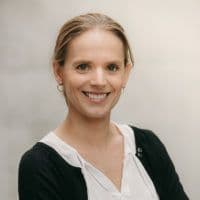
What is your research focus? What initially attracted you to your field?
We apply polymeric molecular and nano- to micron-scale building blocks to assemble soft 3D biomaterials with anisotropic and dynamic properties. Microgels and fibers are produced by technologies based on fiber spinning, microfluidics, and in-mold polymerization. To arrange the building blocks in a spatially controlled manner, self-assembly mechanisms, and assembly by external magnetic fields are employed. Crosslinking micron-scale anisometric microgels with different shapes and aspect ratios together allows us to replace nano-scale polymeric molecules and prepare soft and macroporous hydrogel constructs with programmed architectures for 3D cell growth. In addition, the Anisogel technology offers a solution to regenerate sensitive tissues with an oriented architecture, which requires a low invasive therapy. It can be injected as a liquid and structured in situ in a controlled and unidirectional manner with defined biochemical, mechanical, and physical parameters. While magnetoceptive, anisometric microgels, or short fibers align in situ, a surrounding hydrogel precursor crosslinks to fix the oriented construct so the magnetic field can be removed. Cells and nerves grow in a linear manner, and the fibronectin produced by fibroblasts is also aligned. Regenerated nerves are functional with spontaneous activity and electrical signals propagating along the anisotropy axis of the material. Another developed platform is a thermoresponsive hydrogel system, encapsulated with plasmonic gold-nanorods, which actuates by oscillating light. This system elucidates how rapid hydrogel beating leads to a reduction in cell migration while enhancing focal adhesions, native production of the extracellular matrix, and nuclear translocation of mechanosensitive proteins, depending on the amplitude and frequency of actuation.
What do you hope to bring to your journal?
My aim is to support the applications of papers in the biomaterial field. We want to publish innovative material approaches that connect chemistry, engineering, and biology and hold high potential to solve existing challenges in society and improve quality of life. I value well-characterized systems with all required controls to prove functionality and demonstrate how materials interact with their environment and how this can be controlled by altering specific design parameters.
What are the major challenges facing your field today?
There is still a lot unknown how the interplay of material properties, like the internal structure, degradation rate, stiffness, visco-elasticity, and ligand density, work, the presence of several growth factors and cytokines over time, and the culture conditions, such as flow, direct cells into mature tissue, including the formation of a natural extracellular matrix. This is a dynamic process, and the material systems have to be able to adapt spatially to the changing needs in time. Therefore, materials and potentially cells have to be programmed to respond accordingly to internal or external triggers. In addition, it is often difficult to decouple the effect of multiple parameters on the response of the material and/or environment. A combination of different analysis methods from different fields is often required to characterize this, and analysis methods can have their limitations in sensitivity and scale. Therefore, it is crucial to work in an interdisciplinary manner.
What do you think is the most interesting and/or important unsolved problem in your field?
The holy grail in tissue engineering is still the formation of functional blood vessels to keep growing 3D tissues alive.
Do you have a recent paper in an ACS journal that you’d like to highlight?
Solvent-Induced Nanotopographies of Single Microfibers Regulate Cell Mechanotransduction
ACS Appl. Mater. Interfaces 2019, 11, 8, 7671–7685
DOI: 10.1021/acsami.8b17955
Anything else you’d like readers to know about you?
My dream is to have a healthy and happy life with family and friends so I can, together with my research group and institute, further develop our Anisogel system and get it into people that suffered from spinal cord injury. Hopefully, we can help to trigger regrowth and reconnection of functional nerves, which can lead to regaining some function after injury.
Jiagang Wu, ACS Applied Materials & Interfaces
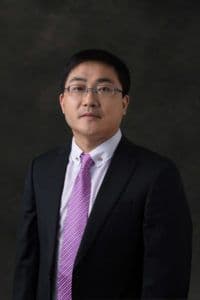
What is your research focus? What initially attracted you to your field?
My group focuses on the ferroelectric/piezoelectric/dielectric functional materials, particularly studying the relationship of “structure-property-application” in these functional materials containing no lead (Pb) and exploring the underlying physical mechanism. I was initially attracted by the piezoelectric effect that interconverts mechanical energy and electrical energy and is applied in kinds of fields. However, commercial piezoelectric materials are currently dominated by Pb-based ones. The lead in these ceramics is a pollution source for our environment and health because of its toxicity, and the worldwide legislations (i.e., RoHS) are minimizing the use of toxic materials, especially Pb and PbO, in the end, consumer products. Therefore, developing high-performance Pb-free ferroelectric/piezoelectric materials makes the environment avoid highly toxic Pb, which greatly benefits human beings and promotes sustainable development.
What do you hope to bring to your journal?
The ACS Applied Materials & Interfaces has a reputation for publishing newly-discovered materials and interfacial processes for specific applications. I hope the journal will benefit from my expertise in ferroelectric/piezoelectric/dielectric materials from inorganic to organic and becomes a high-level communication platform for these functional materials.
What are the major challenges facing your field today?
Developing reliable Pb-free ferroelectric/piezoelectric materials with high performance and transferring them into extensive practical applications.
What do you think is the most interesting and/or important unsolved problem in your field?
Unfolding the physical origin of the high piezoelectric properties observed in both Pb-free and Pb-based piezoceramics. Establishing the relationship between structure and property of ferroelectric/piezoelectric materials. How to transfer the lead-free ferroelectric/piezoelectric materials into extensive applications.
Do you have a recent paper in an ACS journal that you’d like to highlight?
Potassium–Sodium Niobate Lead-Free Piezoelectric Materials: Past, Present, and Future of Phase Boundaries
Chemical Reviews 2015, 115(7), pp 2559-2595
DOI: 10.1021/cr5006809
This paper reviews the development of phase boundaries and piezoelectric properties of one promising lead-free piezoceramic, potassium sodium niobate {(K, Na)NbO3, KNN}. High-performance piezoceramics, which interconvert mechanical energy and electrical energy, are some of the most important and widely used materials for kinds of electronic devices. Because of the high piezoelectricity, low cost, and favorable stability, lead (Pb)-based piezoceramics, such as lead zirconate titanate {Pb(Ti, Zr)O3, PZT}, have dominated the market since the 1950s. However, the high content of toxic Pb in Pb-based piezoceramics contaminates the environment and harms human health. Other works and our previous work have demonstrated that KNN-based piezoceramics with phase boundaries, particularly the ones with a new phase boundary, are one of the most promising lead-free candidates for partly replacing lead-based counterparts. Therefore, we composed this review to help the future development of KNN-based piezoceramics and benefit other lead-free piezoceramics.
Jerome Claverie, ACS Applied Nano Materials
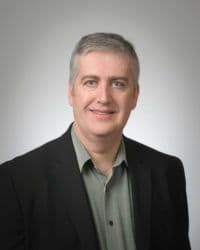
What is your research focus? What initially attracted you to your field?
My research pertains to the synthesis, characterization, and evaluation of hybrid (organic/inorganic) nanomaterials. I was educated as a polymer chemist, but over time, the objects we played with in the laboratory contain more and more inorganic nanoparticles and less and less polymer! Recently, we started to work in the domain of heterogeneous photocatalysis, a domain that I find particularly fun and challenging.
What do you hope to bring to your journal?
My experience as an associate editor is still very novel, and I still have to learn a lot. Therefore, I am not yet sure what I will bring to ACS Applied Nano Materials. This said, reading everyday manuscripts from the journal is a joy. It is humbling to learn about so many ingenious ideas and well-performed studies.
What are the major challenges facing your field today?
I feel that most authors are enthusiastic about their work, from time to time, to the detriment of scientific rigor. Quebecers would say that these authors are ‘cutting round corners.’ I like when a nice story is supported by all possible control experiments. Only such papers will still be of use in fifty years from now.
What do you think is the most interesting and/or important unsolved problem in your field?
ACS Applied Nano Materials is all about the potential applications of nanomaterials. Such materials are key enablers for tomorrow’s technologies associated with sustainable energy conversion and storage. Currently, I cannot imagine anything more urgent to solve for our future.
Do you have a recent paper in an ACS journal that you’d like to highlight?
Everyone in my group was particularly impressed by the paper ‘Perfect Photon-to-Hydrogen Conversion Efficiency‘ published by Kalisman et al. in Nano Letters in 2016. It was the object of lively debates on whether achieving 100% efficiency would break the second principle of thermodynamics. I thought the paper by Chyan et al. entitled ‘Graphene Art‘ published in ACS Applied Nano Materials in 2019 was remarkably pleasant to read.
Jae-Hong Kim, ACS ES&T Engineering

What is your research focus? What initially attracted you to your field?
My research focuses on diverse aspects of advanced materials and processes designed to treat polluted water. More recently, I have been developing various catalytic nanomaterials and single-atom catalysts for the destruction of recalcitrant organic pollutants and inactivation of pathogenic microorganisms in photocatalytic, catalytic, and electrochemical devices. The overarching goal of my research is to develop next-generation, high-efficiency, and low-cost water treatment technologies that can provide clean water to people in need as well as to support the sustained growth of water-dependent industries.
What do you hope to bring to your journal?
The field of environmental engineering has been rapidly evolving from its traditional root in infrastructure engineering to a highly interdisciplinary field of study dealing with forefront advances in chemistry, microbiology, materials science, and data science. Tools that modern environmental engineers use have also been rapidly expanding, from state-of-the-art spectroscopic tools to advanced machine learning algorithms. These changes have been driven by the continuous emergence of increasingly complex environmental problems that cannot be solved by the skill sets and knowledge confined within traditional disciplinary boundaries. I hope to help this new journal become the venue for interdisciplinary engineering research beyond traditional environmental engineering.
What are the major challenges facing your field today?
Some of the major challenges that require innovative, interdisciplinary engineering solutions include climate change, shortages of fresh water and nutrients, new persistent pollutants such as PFAS and microplastics, emerging pathogens, population growth, and massive air pollution, to name a few.
What do you think is the most interesting and/or important unsolved problem in your field?
Many new materials are continuously being introduced to the field to achieve some extraordinary capabilities to detect, remove, and destroy pollutants in water, soil, and air. It is important that these materials are developed with a clear goal of environmental applications. Environmental application contrasts with many other applications due to the complexity of the environmental matrix and the large scale of systems involved. Much materials-based research, despite scientific significance, fails to transfer to real-world applications. I would be most excited to see these innovative materials and systems make breakthroughs in real-world environmental remediation practices.
Do you have a recent paper in an ACS journal that you’d like to highlight?
Farm-to-Tap Water Treatment: Naturally-Sourced Photosensitizers for Enhanced Solar Disinfection of Drinking
ACS EST Engg. 2020, XXXX, XXX, XXX-XXX
DOI: 10.1021/acsestengg.0c00067
Anything else you’d like readers to know about you?
I am excited about the opportunity to get to know researchers, especially junior faculty and students, around the world through this Associate Editor role. Please do not hesitate to contact me to introduce yourself and ask anything about ACS ES&T Engineering.
Julie Granger, ACS Earth and Space Chemistry

What is your research focus? What initially attracted you to your field?
I am fascinated by micro-organisms in the environment, amazed at how their combined activities ultimately drive global biogeochemical cycling of elements in the Earth system. More specifically, I study nitrogen cycling in the marine environment to understand how natural and pollutant sources of nitrogen influence nearshore water quality and open ocean fertility. I strive to uncover how the combined activities of diverse microbes in the ocean contribute to the production, cycling, and loss of reactive nitrogen from marine ecosystems. To this end, I measure the naturally occurring nitrogen isotope ratios of reactive pools in the environment, which provide an integrative tracer of nitrogen sources and cycling. I also conduct laboratory experiments to uncover how different functional groups of micro-organisms fractionate nitrogen isotopes during biochemical transformations, in order to identify the contributions of specific microbial reactions in the environment from stable isotope distributions. My work thus reflects the different scales of nitrogen biogeochemistry, from biochemical to global.
What do you hope to bring to your journal?
I will strive to maintain rigor and impartiality in the review process, and thus elevate the standing of this relatively new journal as an avenue to disseminate important findings in ocean chemistry.
What are the major challenges facing your field today?
The ocean plays a central role in buffering atmospheric CO2 and in absorbing the excess heat generated from anthropogenic greenhouse trapping. The physical, chemical, and biological processes mediating these processes act on multiple spatial and temporal scales. Given the breadth and mutability of the ocean system, an inherent challenge of oceanography resides in collecting sufficient observations to characterize ongoing processes and their rate of change, and to uncover intrinsic drivers. The ongoing development and deployment of autonomous measurement platforms, the utilization of satellite-borne data, the continued effort to monitor ocean properties from ship-board hydrographic surveys, and the exploitation of ocean circulation models continually drive us toward a better understanding of the ocean’s role in maintaining a habitable planet.
What do you think is the most interesting and/or important unsolved problem in your field?
Nitrogen is an essential nutrient for phytoplankton growth, and its supply to the surface ocean exerts a first-order control on ocean fertility and on the consequent sequestration of CO2 into the ocean interior via the biological carbon pump. Yet the dominant source and sink terms of reactive nitrogen to the ocean remain poorly constrained. Unlike other plant nutrients that derive from weathering, the natural supply and removal terms of reactive nitrogen to the ocean are entirely biological: Reactive nitrogen is introduced to the ocean (and the biosphere) by microbial nitrogen fixation of inert atmospheric N2 gas to ammonia, and removed from the ocean by bacterial denitrification, returning reactive N species to N2 gas. Reactive nitrogen is also added to the ocean in large quantities from industrial nitrogen fixation (i.e., the Haber Bosch process). Given the vast expanse of the ocean and its mutability, constraining the amplitude of fluxes and defining environment controls on pertinent processes present a unique yet fundamental challenge. My research aims to provide some resolution to these quandaries.
Do you have a recent paper in an ACS journal that you’d like to highlight?
Constraining the Oxygen Isotopic Composition of Nitrate Produced by Nitrification
Environ. Sci. Technol. 2019, 53, 3, 1206–1216
DOI: 10.1021/acs.est.8b03386
Helena J. Shepherd, Crystal Growth & Design
What is your research focus? What initially attracted you to your field?
My research group at the University of Kent (UK) focuses on stimuli-responsive molecular materials in the solid-state. We are interested in a range of systems, from organometallic complexes that switch their spin state in response to changes in temperature, pressure, light, etc. to organic photoswitches that undergo dramatic changes in color and structure. I have group members working on many different aspects of these materials, including synthesis and scale-up processes, detailed structure-property correlations, and the development of new applications. I think what attracts me to these materials is the huge capacity for atomic and molecular motion, even in the solid-state. The ability to gain a fundamental understanding of these dynamic processes is vital to their development, but exploiting them for real-world applications is the next big challenge that keeps me coming back to these beautiful materials.
What do you hope to bring to your journal?
I have a background in structural chemistry but have used a lot of different techniques not only to understand the link between structure and properties but also in efforts to control it. I would like to use this opportunity at Crystal Growth and Design to demonstrate just how active – and exciting – molecular materials can be.
What are the major challenges facing your field today?
Anisotropy in molecular materials makes understanding cooperative processes such as phase transitions very difficult – properties arise as a complex combination of both intramolecular bonding and intermolecular interactions. Furthermore, we are increasingly finding that useful properties often arise not from the bulk of materials but from surfaces, defects, and dynamic processes occurring at very small length scales. Using traditional structural techniques, it is very difficult to see beyond the bulk, and these fundamentally important details are lost. I think these major challenges are inherently linked to huge opportunities – developments in traditional experimental hardware and advances in techniques such as electron diffraction mean we are no longer restricted to observation of the average structure of a material. I look forward to seeing how far we can go in understanding the world – in all its complexity – down to the atomic scale.
Q10. What do you think is the most interesting and/or important unsolved problem in your field?
Designing new responsive molecular materials with specific properties tuned to any given technological application and operating conditions.
Do you have a recent paper in an ACS journal that you’d like to highlight?
Complete Set of Elastic Moduli of a Spin-Crossover Solid: Spin-State Dependence and Mechanical Actuation
J. Am. Chem. Soc. 2018, 140, 28, 8970–8979
DOI: 10.1021/jacs.8b05347
Understanding anisotropic mechanical properties and processes will be increasingly important as we employ more molecular materials in advanced technologies. This paper is the result of a large collaboration between chemists, physicists, and materials scientists seeking to understand the mechanical properties of spin crossover systems, led by colleagues at the LCC-CNRS in Toulouse, France. By combining nuclear inelastic scattering, high-pressure single-crystal X-ray diffraction, and micromechanical resonance experiments, we were able to obtain a complete characterization of the elastic properties of the molecular compound. These measurements reveal a relatively stiff molecular lattice, which displays a pronounced, anisotropic softening upon the transition from low- to high-spin. These different characteristics are correlated with the strong cooperativity (of elastic origin) observed in some spin crossover materials and also allowed for the assessment of the actuating performance of thin films of such materials. As such, this work paves the way for the effective integration of spin crossover complexes into mechanical actuators and also provides a better understanding of the electron−lattice coupling, which to a large extent, governs the spin crossover properties.
Hai-Bo Yang, Crystal Growth & Design
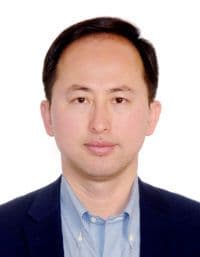
What is your research focus? What initially attracted you to your field?
My research interests focus on supramolecular chemistry, especially supramolecular self-assembly, supramolecular polymers, and rotaxane dendrimers. I am always fascinated by the beauty of the biological self-assembly in Nature, and I am very curious that whether we can use the great power of chemical self-assembly towards the construction of complex matters with intriguing properties and wide applications.
What do you hope to bring to your journal?
I hope that some concepts and approaches in supramolecular self-assembly will appear in Crystal Growth & Design. Actually, in some cases, the crystal growth and design are inspired by non-covalent interactions in supramolecular self-assembly.
What are the major challenges facing your field today?
Although supramolecular self-assembly has been well developed during the past few decades, there are still many challenges in this field. For example, it is still very difficult to realize well-controlled self-assembly towards complex matters in the lab. Moreover, it is still challenging to set up a bridge between the fundamental research and practical applications of supramolecular self-assembly.
What do you think is the most interesting and/or important unsolved problem in your field?
How to realize the hierarchical self-assembly towards the controllable and programable construction of complex matters with predicted properties and functions at different scales.
Do you have a recent paper in an ACS journal that you’d like to highlight?
Construction of Stimuli-Responsive Functional Materials via Hierarchical Self-Assembly Involving Coordination Interactions
Acc. Chem. Res. 2018, 51, 11, 2699–2710
DOI: 10.1021/acs.accounts.8b00317
Recently, my group has published an account in Accounts of Chemical Research in which we summarized our expedition in the construction of stimuli-responsive functional materials via hierarchical self-assembly involving coordination interactions.
Anything else you’d like readers to know about you?
I like listening to some Chinese traditional music in my spare time. Moreover, I enjoy learning about cultures from different places in the world when I travel abroad.
Doris Braun, Crystal Growth & Design
What is your research focus? What initially attracted you to your field?
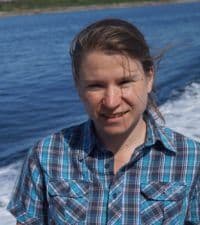
The “Preformulation and Polymorphism group” at the University of Innsbruck focuses on scientific and applied problems related to solid-state properties of pharmaceuticals and other small organic molecules of high industrial relevance. We develop methods, strategies, and guidelines for the production and characterization of solid-state forms. Based on systematic explorations of structure-property relationships, we work towards an understanding of the factors that lead to multiple crystal forms (polymorphs, hydrates, solvates, co-crystals). Particularly, my research focuses on (1) the role of computational chemistry for (pharmaceutical) solid form screening and characterization: how to implement crystal structure prediction into solid form screening and characterization programs, (2) thermodynamic relations in solid forms: how to derive the thermodynamic stability order of different solid-state forms, and (3) the important solid form class of hydrates (water adducts): prediction, characterization and practical consequences of hydrate formation. Already as an undergraduate student, I became familiar with solid-state problems of organic/drug compounds, and the phenomenon of polymorphism fascinated me. My high interest in this research area made me decide to proceed scientifically in this field.
What do you hope to bring to your journal?
With my background (University training) being in Pharmacy and having worked on projects focusing on basic research and industrial problems, materials properties and their applicability have always been the driving force for my research. Furthermore, as a scientist, I have taken the role of an experimentalist among world-leading theoretical chemists and am now applying computational chemistry in an otherwise experimentally focused research group. Hence, my scientific path shaped me to address problems by complementing theoretical and experimental approaches and to combine different research areas. Therefore, I am hoping that my experience will further strengthen the excellent team of CG&D and that together we can promote out of the box thinking of scientists and engineers working in the field and foster new young talents.
What are the major challenges facing your field today?
Over the last decade, there have been ground-breaking changes in the research field of “polymorphism.” Computational chemistry can be used to predict feasible crystal structures of small pharmaceuticals from the molecular geometry alone as a starting point. Experimental techniques have advanced that intermediate solid forms can be detected and even structurally characterized. High-resolution data collections allow us to get insights into the structural behavior and interrelations of solid-state forms. Thus, the challenges we have to overcome in our field are often not related to the science but are linked to the accessibility of the (newest) techniques, the time we can spend working on a compound, and the funding opportunities available.
What do you think is the most interesting and/or important unsolved problem in your field?
Despite of the ground-breaking advances in the field and the efforts that are undertaken by the scientist in academia and industry worldwide we are still not able to predict if a molecule will crystallize, let alone in what forms or under which conditions. The required breakthrough is probably understanding nucleation and growth in practically relevant systems. The ultimate goal is then to design and produce the assembly of new materials with targeted properties.
Do you have a recent paper in an ACS journal that you’d like to highlight?
Inconvenient Truths about Solid Form Landscapes Revealed in the Polymorphs and Hydrates of Gandotinib
Cryst. Growth Des. 2019, 19, 5, 2947–2962
DOI: 10.1021/acs.cgd.9b00162
The extensive experimental and computational study not only highlights the state of the art in the solid state characterization of crystal forms of a flexible drug molecule, but it also reveals many inconvenient truths about solid form landscapes and the effort that is sometimes required to identify solid forms, characterize their properties and determine when it is appropriate to discontinue solid form screening. The understanding of the solid state landscape of the drug molecule was only achieved through joined efforts of experimentalists and theoreticians working in industry and academia.
Shuang-Quan ZangCrystal Growth & Design
What is your research focus? What initially attracted you to your field?
Metal clusters, Metal-organic framework, Crystal engineering. The fascinating crystal color and morphology attracted me.
What do you hope to bring to your journal?
I want to expand our influence among Asians, especially among Chinese researchers.
What are the major challenges facing your field today?
The major challenge in metal clusters may the functionalization and application.
What do you think is the most interesting and/or important unsolved problem in your field?
The most interesting may be the chirality of metal clusters.
Do you have a recent paper in an ACS journal that you’d like to highlight?
Cluster-Assembled Materials
ACS Nano 2009, 3, 2, 244–255
DOI: 10.1021/nn800820e
Anything else you’d like readers to know about you?
Here’s my ORCID. I would like readers to know more about the College of Chemistry, Zhengzhou University.
Len Barbour, Crystal Growth & Design

What is your research focus? What initially attracted you to your field?
I am interested in all aspects of solid-state supramolecular chemistry, but particularly with regard to shedding light on structure-property relationships. My main focus is on the characterization of porous crystalline materials. I am attracted to this area because porosity at the molecular level is an unusual, even counterintuitive phenomenon. Molecules prefer to pack efficiently, which leaves little space for accommodating small guest species. However, we are learning how to overcome close-packing tendencies, thereby creating a vast library of new porous materials that can be tuned for various applications involving molecular recognition.
What do you hope to bring to your journal?
What are the major challenges facing your field today?
I am certainly an advocate of exploratory research aimed at bettering our understanding of how and why materials behave the way that they do – i.e., relating structure and function. In fact, most of my own research is focused on exploring molecular space without necessarily having a commercial application in mind every time. However, one of the most difficult leaps in any field is to recognize how an intellectually interesting phenomenon might be put to good use. I believe that the biggest challenge in the field of crystal engineering is to take the next step by translating tuneable properties into useful devices. This requires imagination that transcends the rigorous training that scientists usually receive.
What do you think is the most interesting and/or important unsolved problem in your field?
Crystal structure prediction has come a long way in the past two decades. I believe that we are heading towards a future where structures and their properties will be predicted as a matter of routine.
Do you have a recent paper in an ACS journal that you’d like to highlight?
Record-Setting Selectivity for p-Xylene by an Intrinsically Porous Zero-Dimensional Metallocycle
J. Am. Chem. Soc. 2020, 142, 10, 4529–4533
DOI: 10.1021/jacs.9b11314
We have been exploring discrete dinuclear metallocycles as the building blocks of porous materials for the past 15 years. These are conceptually donut-shaped metal complexes that are capable of stacking in the solid state such that their ‘holes’ line up to form channels. Sometimes these channels aren’t continuous, but the concerted motion of the flexible metallocycles can cause neighboring holes to merge fleetingly, thus creating transient pores. The structural flexibility of the material allows the pores to adapt to small guest molecules according to their size and shape, with the possibility of recognizing one isomer in a mixture. We demonstrated that one of our metallocycles exhibits record-setting selectivity for the commercially important para-xylene from a mixture of the three xylene isomers. In fact, the material is even capable of removing para-xylene from commercially pure (>99%) ortho-xylene.
Anything else you’d like readers to know about you?
Had I not become a chemist I would probably have been an engineer. I am deeply interested in woodwork, metalwork, electronics, and software development. In addition to being satisfying hobbies, these interests have been immensely helpful in developing new research tools to facilitate my work.
Xin Zhang, Crystal Growth & Design

What is your research focus? What initially attracted you to your field?
I work on crystal growth, surface science, and material synthesis for the environment, energy, and catalysis. Building nanostructures has been widely embraced as a strategy to control the chemical and physical properties of materials, which attracted me to work in this field.
What do you hope to bring to your journal?
I want to encourage researchers to publish high-quality papers and attract more audiences.
What are the major challenges facing your field today?
Imaging the solution, ion, and surface structures that create the forces to drive the cluster/particle aggregation; Size, shape, and facet-controlled synthesis of nanocrystals via additive-free methods; Design and develop novel nanomaterials via machine learning coupled with high throughput experimentation; Directly imaging the nucleation in atomic level; Directly imaging the crystallization in extreme environments, such as high temperature, high pressure, radiation, and ultra-low/high pH.
What do you think is the most interesting and/or important unsolved problem in your field?
The solution, ion, and surface structures which create the forces to drive the cluster/particle aggregation.
Do you have a recent paper in an ACS journal that you’d like to highlight?
Effect of Cr(III) Adsorption on the Dissolution of Boehmite Nanoparticles in Caustic Solution
Environ. Sci. Technol. 2020, 54, 10, 6375–6384
DOI: 10.1021/acs.est.9b07881
Kenneth Kam-Wing Lo, Inorganic Chemistry
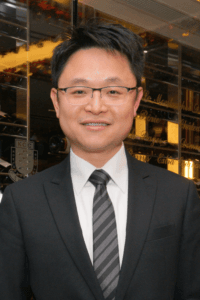
What is your research focus? What initially attracted you to your field?
My research focuses on the utilization of photofunctional transition metal complexes as biomolecular probes and cellular reagents, with an emphasis on the development of intracellular sensors, bioorthogonal probes, live-cell imaging reagents, and photodynamic therapeutics. My Ph.D. investigated the photophysical, and photochemical properties of coordination and organometallic complexes, whilst my postdoc training researched the genetic engineering of cytochrome P450cam mutants. I found these areas fascinating and so planned to investigate them further when I started my independent career. This interest grew and eventually led to the theme of my current research, which lies at the interface of coordination chemistry, photochemistry, and biological sciences.
What do you hope to bring to your journal?
I am looking forward to working with the Editor-in-Chief and Associate Editors and continuing their remarkable effort in helping to get the best work published in Inorganic Chemistry. I wish to contribute by further expanding the audience of the journal; for example, I will attempt to showcase the journal to more young and junior scientists, not only in the area of inorganic chemistry but also in related disciplines. With my background in inorganic photochemistry and bioinorganic chemistry, I will highlight the importance of inorganic chemistry and its relevance to other areas through the organization of special issues, forums, and other initiatives.
What are the major challenges facing your field today?
Although the interactions of transition metal complexes with many biological molecules have been unraveled, there are still challenges to overcome if the interesting properties of metal complexes such as luminescence, magnetic, redox, etc., are to be fully utilized for biological applications. The major problems that confront us when we design bioimaging reagents are the high cytotoxicity and low water solubility of many luminescent transition metal complexes. Although these can be circumvented by modifying the complexes with poly(ethylene glycol), we have to ensure that the PEGylation process will not cause any adverse effects to the luminescence, biomolecular recognition, intracellular localization, and detection sensitivity of the complexes. Another major target is the design of transition metal complexes with lower emission energy as a means to suppress phototoxicity, enhance tissue penetration, and increase image resolution. The main important challenge is how to achieve this whilst maintaining high emission quantum yields and long emission lifetimes of the complexes.
What do you think is the most interesting and/or important unsolved problem in your field?
In the broad area of inorganic photochemistry, there are many important topics that deserve attention; for example, photocatalysts for water splitting and organic transformations; inorganic materials for dye-sensitized solar cells, dopants for phosphorescent OLEDs; etc. For bioinorganic chemistry, the important role of metals in medicine continues to attract interest; for example, metal complexes as anticancer drugs, antiparasitics, and photodynamic therapeutics; diagnostic and therapeutic radiopharmaceuticals; contrast reagents for MRI; luminescent sensors and imaging reagents for time-resolved microscopy, etc. These are all challenges and opportunities for inorganic chemists.
Do you have a recent paper in an ACS journal that you’d like to highlight?
Molecular Design of Bioorthogonal Probes and Imaging Reagents Derived from Photofunctional Transition Metal Complexes
Accounts of Chemical Research, 2020, 53, 32 – 44.
DOI: 10.1021/acs.accounts.9b00416
Feng Qian, Molecular Pharmaceutics

What is your research focus? What initially attracted you to your field?
My research interests include several areas:
- Novel while translatable anti-cancer drug therapeutics and drug delivery technologies, utilizing the unique biological characteristics of solid tumors (such as pancreatic cancer).
- Bioavailability enhancement of poorly soluble and poorly absorbable drugs.
- High concentration protein formulation for subcutaneous, intravitreal, etc. injection.
In all these research efforts, I hope we can come up with some unique therapeutic design based on an in-depth understanding of disease biology and clinically translatable engineering design, that could eventually help patients. In parallel with that, we strive to understand the basic physical chemistry principles of various drug delivery systems to provide insight for future formulation design tasks.
What do you hope to bring to your journal?
I worked in the pharmaceutical industry for almost 10 years before I became an academic professor in 2012. My own research is also extremely multidisciplinary in nature, ranging from biomedical engineering, drug delivery, physical pharmacy, translational medicine, etc. Such experience helps me a lot to assess the significance, impact, and quality of a research topic from different angles.
What are the major challenges facing your field today?
In my understanding, the goal of drug delivery and molecular pharmaceutics research is to offer at least one of the following: 1) Novel and viable therapeutics, 2) Reveal any previously unknown action mechanisms, 3) Provide scientific guidance or insight for industrial formulation design and development. I found it’s difficult to see these goals in some research work. We need more high-quality researches to solve real clinical or industrial problems.
What do you think is the most interesting and/or important unsolved problem in your field?
Be able to deliver and formulate continuously evolving novel therapeutic agents. A few examples include compounds with extremely narrow therapeutic window yet pharmacologically unique; oral delivery of small molecules that are beyond Lipinski’s Rule of 5, etc.; gene therapies; intracellular delivery of protein therapeutics, etc.
Do you have a recent paper in an ACS journal that you’d like to highlight?
Targeting the Oncogene KRAS Mutant Pancreatic Cancer by Synergistic Blocking of Lysosomal Acidification and Rapid Drug Release
ACS Nano, 2019 Apr 23;13(4):4049-4063
DOI: 10.1021/acsnano.8b08246